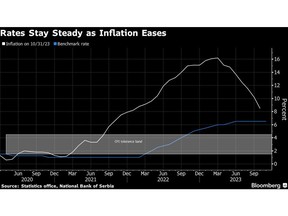Serbia left borrowing costs unchanged for a fifth month after the country’s steepest monetary tightening on record helped curb inflation without hurting economic growth.
Author of the article:
Bloomberg News
Misha Savic
Published Dec 07, 2023 • Last updated 1 hour ago • 2 minute read
 ipc}9p0ua(n9uq8h3vneirq{_media_dl_1.png Bloomberg RSS
ipc}9p0ua(n9uq8h3vneirq{_media_dl_1.png Bloomberg RSS
(Bloomberg) — Serbia left borrowing costs unchanged for a fifth month after the country’s steepest monetary tightening on record helped curb inflation without hurting economic growth.
The National Bank of Serbia kept its one-week repurchase rate at 6.5% on Thursday, the highest level in more than eight years, matching the forecasts of all analysts in a Bloomberg survey. Economists also see headline inflation easing further in the coming months, after dropping to 8.5% in October from a 16.2% peak in March.
Advertisement 2
This advertisement has not loaded yet, but your article continues below.
THIS CONTENT IS RESERVED FOR SUBSCRIBERS ONLY
Subscribe now to read the latest news in your city and across Canada.
Exclusive articles from Barbara Shecter, Joe O’Connor, Gabriel Friedman, Victoria Wells and others.Daily content from Financial Times, the world’s leading global business publication.Unlimited online access to read articles from Financial Post, National Post and 15 news sites across Canada with one account.National Post ePaper, an electronic replica of the print edition to view on any device, share and comment on.Daily puzzles, including the New York Times Crossword.
SUBSCRIBE TO UNLOCK MORE ARTICLES
Subscribe now to read the latest news in your city and across Canada.
Exclusive articles from Barbara Shecter, Joe O’Connor, Gabriel Friedman, Victoria Wells and others.Daily content from Financial Times, the world’s leading global business publication.Unlimited online access to read articles from Financial Post, National Post and 15 news sites across Canada with one account.National Post ePaper, an electronic replica of the print edition to view on any device, share and comment on.Daily puzzles, including the New York Times Crossword.
REGISTER TO UNLOCK MORE ARTICLES
Create an account or sign in to continue with your reading experience.
Access articles from across Canada with one account.Share your thoughts and join the conversation in the comments.Enjoy additional articles per month.Get email updates from your favourite authors.
Article content
Article content
The rate decision followed “easing of global inflationary pressures, as well as an established downward trajectory of domestic inflation and its return to the target range in the middle of next year,” the central bank said in a statement.
The Balkan nation’s economy is proving to be more resilient than many of its eastern European peers to tight monetary conditions and global shocks, expanding more than expected in the third quarter. Gross domestic product rose 3.6% in the July-September period from a year earlier, supporting the government’s forecast for at least 2.5% full-year growth.
The core consumer price gauge, which excludes the most volatile items, has trailed headline inflation during the price surge. The monetary authority has repeatedly said that most of the price pressures are caused by external factors, notably energy and food, which cannot be tackled by domestic policy.
Still, the bank deployed a tightening push that lifted the main rate by a cumulative 550 basis points over 16 months through July. Policymakers have said that if some price pressures return, they may act with alternative tightening tools, such as mopping up excess liquidity from the banking system or increasing the mandatory reserves requirement for lenders.
Advertisement 3
This advertisement has not loaded yet, but your article continues below.
Article content
The statistics office is due to release the consumer-price index for November next week. The reading is likely to show the impact of an increase in state-regulated power and gas prices that took effect last month. The government is also raising public wages and pensions as the country heads for early general elections on Dec. 17.
The monetary authority sees consumer price growth returning to the 1.5%-4.5% tolerance band in the second quarter of 2024. Real interest rates may turn positive already in the first three months of next year, or early in the second quarter, due to a steady decline in annual inflation, central bank Governor Jorgovanka Tabakovic said last month.
—With assistance from Harumi Ichikura.
(Updates with central bank comments in third paragraph.)
Article content
>>> Read full article>>>
Copyright for syndicated content belongs to the linked Source : Financial Post – https://financialpost.com/pmn/business-pmn/serbia-holds-rates-after-record-hikes-helped-tame-high-inflation































